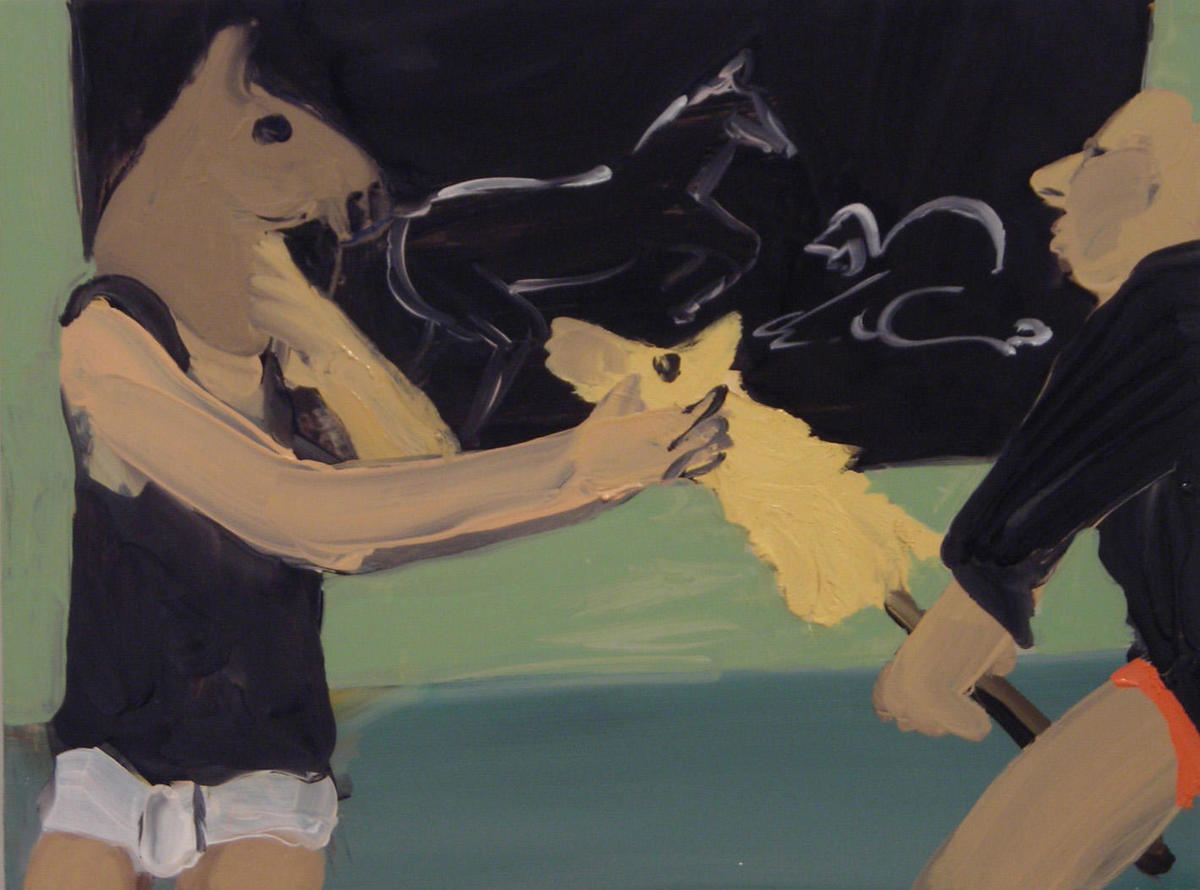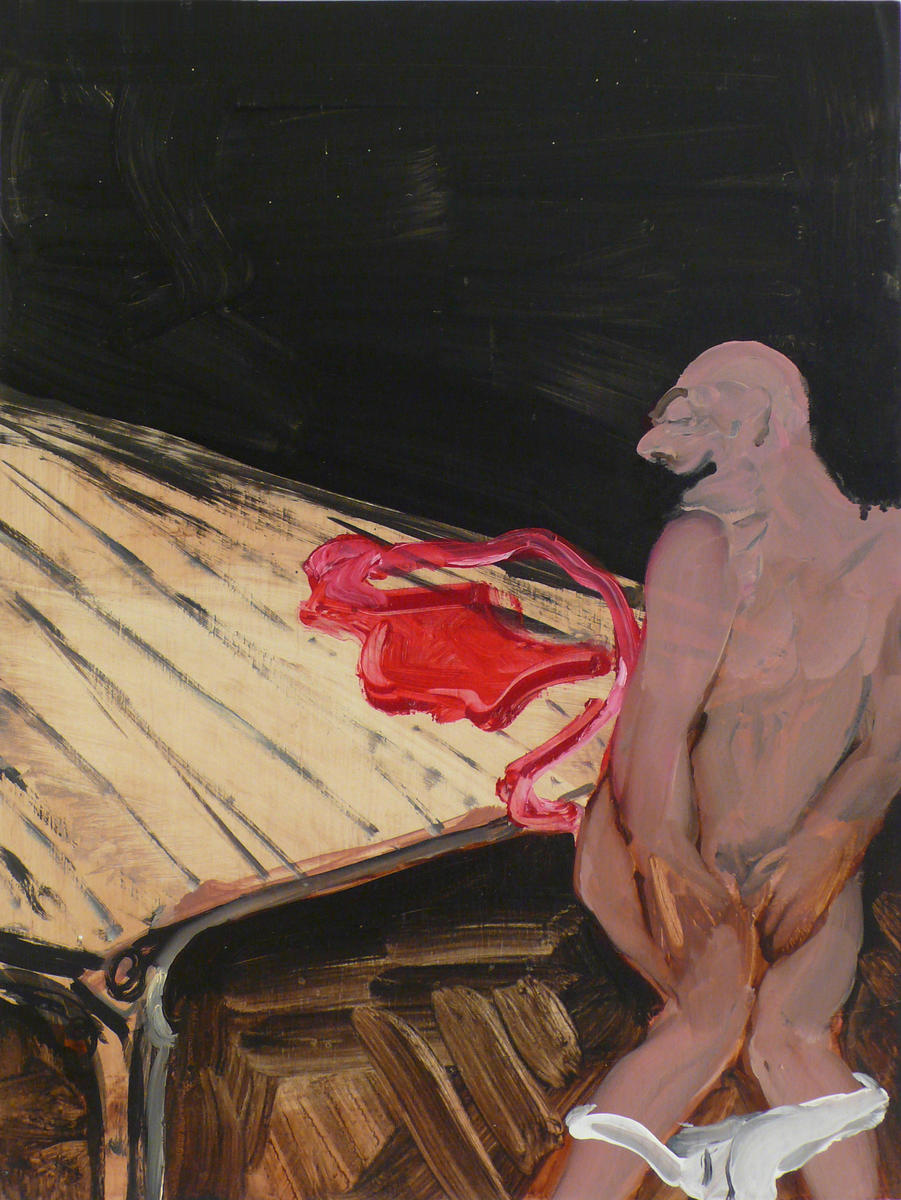
New York
Tala Madani: Aas-as-sin: hashish, anyone?
Lombard-Freid Projects
April 25–May 1, 2008
In 2007 Tala Madani presented ‘Smoke and Mirrors,’ her first solo show, at Lombard-Freid Projects. This year the twenty-six-year-old, Iranian-born Yale graduate continued to provoke. Beginning with the show’s title — ‘ASS•AS•SIN: hashish anyone?’ — Madani lent dark humor to the political and cultural murk that seems to be her home and homeland. “Assassin,” of course, derives from “Hashshashin”—a militant Muslim sect that, from the eighth to the fourteenth centuries, murdered in secret its political rivals while gainfully high on hashish and opium. But Madani made her interest in the clandestine, violent, hazy, macho element of her native culture seem not only somewhat creepy but also, occasionally, fun.
Madani’s small-scale, lushly expressionistic mise-en-scènes read more like cartoons, as if each strange canvas were a panel in a larger, more perverse strip, with Li’l Abner played by sundry versions of a stereotypical middle-aged Middle Eastern man: brown, hairy, stupid, and endowed with a big nose. They played games with each other, games which usually involved some mix of weird sex and/or violence. In Apple Job (2007), one such man showed off his bra, each cup stuffed with a green apple, as another, holding a knife, snuck up from behind and copped a feel.
The birthday cakes that were often central to the absurdist setups in ‘Smoke and Mirrors,’ returned in spirit; in Blowing Bright Eyes (2008), a man blew out two birthday candles, only they didn’t sit in a cake but were jammed into another man’s eyes.
Madani also explored pedagogical themes. Many of the scenes were set in a room where the perspective had been shoved to the front so that half of the painting appeared as a blackboard. In these classrooms, the teachers were as dense as the students (who were apparently fond of mooning), and there was little difference between an ass and a bird in flight or a Star of David, between ejaculate and chalk.
Madani conjured these bizarre scenes with her inventive way of pulling, turning, and pushing color to create her characters. The result was a lack of physical detail that echoed the placeless, timeless quality of the works yet left them full of thick painterly gestures and vigorous colors. Flashes of an apple green or hot pink thong leavened otherwise grim subjects. However, the bright room in the painting Pink Western, which should have brought merciful cheer to an uncomfortably rendered homoerotic cowboy game, instead, like a serial killer in clown makeup, just made everything seem more sinister. The small scale and formal obfuscation of Madani’s works allowed for outrageous articulations; her tone was so heavy that detail would have been overkill.
Unfortunately, the large canvases in the show didn’t play to Madani’s strengths. Her deft, sometimes calligraphic strokes got lost in a format that also quickly exhausted her themes. In the bigger pieces, Madani drew more than she painted. Paradoxically, the larger canvases lacked the airiness that ameliorated her weirdness in the smaller works. The larger works also used more blatant art historical references, which young artists love, but whose effect can be plodding.

Madani’s exhibition also featured unexpected first-time experiments with animation. Using a stop-motion method, Madani meticulously painted each frame of her characters acting out their escapades, capturing their movements. Viewers had to look into a wooden conduit to see the small screen at the end, becoming totally absorbed. In Chit Chat, the profiles of two arguing men morphed continuously, from grotesque features to a devil and a chorus of blabbing heads. There was no sound, nor any need for it, as both men were obviously yelling but expressing nothing. The films bespoke Madani’s gift for improvisation, humor, and immediacy. They felt satisfyingly quick despite (or somehow because of?) their dour subjects and the tedious process that yielded them.
At her best, Madani gave us almost no pictorial detail in terms of place, time, or distinguishing features that could humanize her men, letting them instead personify only the vague, shadowy nature of the West’s “East.” In the small paintings, Madani’s strokes and colors elicited pleasure — they obscured but also extemporized the action in the vignettes. As a comment on the West’s understanding of the East, this sadistic stereotyping might have been a little obvious. But for the painter of Panties (2008), subtlety was of little concern. Nor should it have been. The intimacy and skill of Madani’s work let her get away with it.